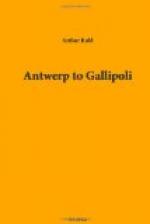There are attractive little chocolate and pastry shops and cheerful semi-pension restaurants where whole families, including, in these days, minor politicians with axes to grind and occasional young women from the boulevards, all dine together in a warm bustle of talk, smoke, the gurgle of claret, and tear off chunks of hard French bread, while madame the proprietress, a handsome, dark-eyed, rather Spanish-looking Bordelaise, sails round, subduing the impatient, smiling at those who wish to be smiled at, and ordering her faithful waiters about like a drill-sergeant.
And then there is the Chapon fin. When you speak to some elderly gentleman with fastidious gastronomical tastes and an acquaintance with southern France of your intention of going to Bordeaux, he murmurs reminiscently: “Ah, yes! There is a restaurant there...” He means the Chapon fin. It was famous in ’70 when the government came here before, and to-day when the young King of Spain motors over from Biarritz he dines there. Coming down on the train, I read in the Revue des Deux Mondes the recollections of a gentleman who was here in ’70-’71 and is here again now. He was inclined to be sarcastic about the present Chapon fin. In his day one had good food and did not pay exorbitantly; now “one needs a quasi-official introduction to penetrate, and the stylish servants, guarding the door like impassable dragons, ask with a discreet air if monsieur has taken care to warn the management of his intention of taking lunch.”
We penetrated without apparent difficulty—possibly owing to the exalted position of the two amiable young attaches who entertained me—and the food was very good. There were diplomats of all sorts to be seen, a meridional head waiter, and an interesting restaurant cat. One end of the room is an artificial grotto, and into and out of the canvas rocks this enormous cat kept creeping, thrusting his round face and blazing eyes out of unexpected holes in the manner of the true carnivora, as if he had been trained by the management as an entertainer. The head waiter would have lured an anchorite into temporary abandon. Toward the end of the evening we discussed the probable character of a certain dessert, suggesting some doubt of taking it. You might as well have doubted his honor. “Mais, monsieur!” He waved his arms. “C’est delicieux! ... C’est merveilleux! ... C’est quelque chose”—slowly, with thumb and first finger pressed together—“de r-r-raf-fi-we!"...
It is to this genial provincial city that the President and his ministers have come. They distributed themselves about town in various public and private buildings; the Senate chose one theatre for its future meeting-place and the Chamber of Deputies another. And from these places, sometimes the most incongruous—one hears, for instance, of M. Delcasse maintaining his dignity in a bedroom now used as the office for the minister of foreign affairs—the red tape is unwound which eventually sends the life-blood of the remotest province flowing up to its appointed place at the front.




